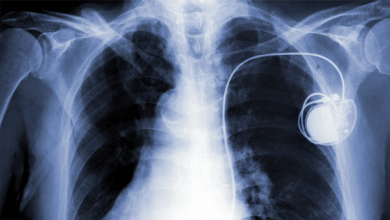Search results
Author(s):
Ivo Planinc
,
Davor Milicic
,
Maja Cikes
Added:
3 years ago
Heart failure (HF) affects more than 2% of the adult population worldwide; it is responsible for about 1 million hospitalisations per year in the US and it carries a high mortality risk.1 Recent population data indicate overall better survival rates, albeit with greater healthcare costs.1 Altogether, HF syndrome represents one of the biggest challenges to modern medicine, and places an enormous…
View more
Author(s):
Haran Burri
Added:
3 years ago
Patients implanted with a pacemaker (PM) or implantable cardioverter defibrillator (ICD) require regular follow-ups to control the proper function of the implanted device. These technical checks have traditionally been performed manually in-office using a dedicated device programmer. In 1971, transtelephonic monitoring was introduced to remotely follow-up basic parameters (such as battery status…
View more
Author(s):
Ryszard Piotrowicz
,
Ewa Piotrowicz
Added:
3 years ago
Telemedicine (TM) (see Table 1) finds its application most commonly in chronic heart failure (HF).1–3 TM can be useful during exercise training (ET) as a tool to control stability of the clinical status of patients and to supervise training sessions. These goals can be achieved by monitoring clinical symptoms (dyspnoea, fatigue, oedema, chest pain, palpitations, etc.) and monitoring parameters …
View more
Author(s):
Ewa Piotrowicz
,
Ryszard Piotrowicz
Added:
3 years ago
Telemedicine (TM) (see Table 1) finds its application most commonly in chronic heart failure (HF).1–3 TM can be useful during exercise training (ET) as a tool to control stability of the clinical status of patients and to supervise training sessions. These goals can be achieved by monitoring clinical symptoms (dyspnoea, fatigue, oedema, chest pain, palpitations, etc.) and monitoring parameters …
View more
Author(s):
Ferdinando Iellamo
,
Barbara Sposato
,
Maurizio Volterrani
Added:
3 years ago
The contemporary treatment planning of heart failure (HF) is based on guideline-directed medical therapy recommendations. The management of HF patients at home has become more driven by symptoms and nurse evaluation, as well as by simple monitoring techniques, such as daily weight measurements, to adjust diuretictherapy.
Noninvasive Monitoring
Nowadays, technological developments have made it…
View more
Author(s):
Gian Franco Gensini
,
Camilla Alderighi
,
Raffaele Rasoini
,
et al
Added:
3 years ago
Telehealth is a multiform term embracing the applications of telematics to medicine, in order to enable diagnosis and/or treatment remotely through a set of communication tools, including phones, smartphones and mobile wireless devices, with or without a video connection.1
Until a few years ago, digital applications in medicine were restricted to the use of data obtained from electronic health…
View more
Author(s):
Darshan H Brahmbhatt
,
Martin R Cowie
Added:
3 years ago
Heart failure (HF) is increasing in prevalence globally, and is associated with considerable ill health, healthcare costs and mortality. Prevalence increases steeply with age, and the average age of a person admitted to hospital with decompensation in developed countries such as the UK is in the high 70s.1 Comorbidity is the rule, with half of hospitalised patients having at least five…
View more
Author(s):
Juan Carlos López-Azor
,
Noelia de la Torre
,
María Dolores García-Cosío Carmena
,
et al
Added:
1 year ago
Telemonitoring in Patients with Heart Failure - Lessons from Recent Randomised Multicentre Trials
Author(s):
Andrea Mortara
Added:
3 years ago
Article
Added:
3 years ago
Vienna, Austria – 17 October 2015: Pacemakers identify atrial fibrillation and enable initiation of anticoagulation to prevent strokes, according to research presented today at Acute Cardiovascular Care 2015 by Dr Nathan Denham, a cardiologist at Warrington Hospital, UK.1
“Atrial fibrillation (AF) is the most common heart rhythm disorder and affects 1.5–2% of people in the developed world,” said…
View more













